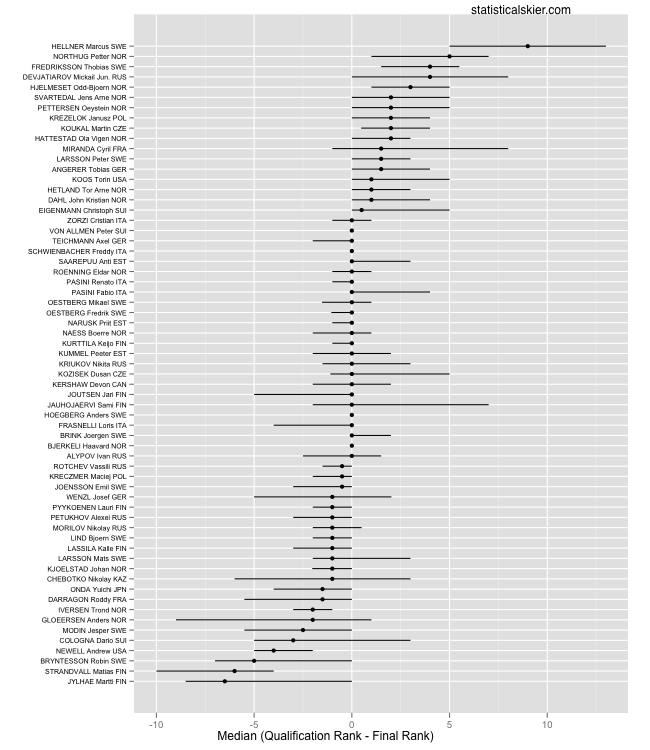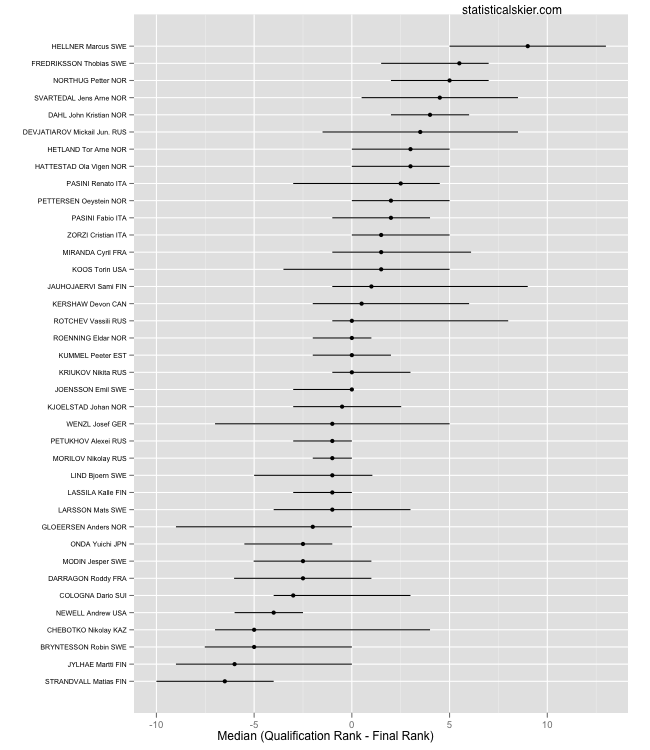Update: I kind of messed this post up a bit. It does change the picture somewhat, so see below for edits.
There are several topics in North American XC skiing that are fairly predictable. One of those is that anytime Andrew Newell posts a blazing fast qualifying time but fails to advance to the finals we’ll see some commentary about how this is a pattern with him. That happened again this past weekend, as he qualified 3rd, almost 4 seconds ahead of eventual winner Emil Jönsson. Still, it’s not like the day was a disaster for Newell, as he had what’s for him an essentially average race, landing in 13th.
But since this question comes up over and over, let’s look at some data to see if we can identify just to what extent this is a trend for Newell, and how it compares to other top skiers.
Here’s the graph we’re going to discuss (Edit: This graph is wrong.):
Edit: Here’s the correct version.
These are male sprinters who’ve had at least 15 top 30 finishes since 2003 2006-2007. I’ve calculated something very simple, the median difference between their qualification rank and their final rank for each top thirty finish. So, for example, on Saturday Newell qualified 3rd and finished 13th, giving us 3-13 = -10. Do this for every top thirty race and then take the median. The error bars are included to give you a sense of the variability at play here. (They are bootstrapped 90% confidence intervals for the median if your care about that sort of thing; since we’re dealing with medians the placement of the median difference within the error bar may appear strange in some cases.)
The first thing I want to emphasize is how many of these skiers experience only very small differences between their qualification and final ranks. Nearly everyone’s median difference falls between (-2.5,2.5), which if you think about it isn’t a terribly large change. The previous sentence is mostly still true, but there are many fewer of these kinds of skiers present.
Now, there are certainly some people who are quite variable. Sami Jauhojaervi, for instance, “typically” ends up about where he qualified, but sometimes does quite a bit better. Cyril Miranda Josef Wenzl follows a similar pattern. For many others, the median difference is much less variable.
The more interesting folks are situated at the top and bottom of this graph. The people at the top tend to qualify near the bottom and then successfully move up quite a ways. The folks at the bottom tend to do just the opposite. Marcus Hellner seems to be the master of qualifying slowly and then advancing through the heats quite far. At the other end, there are only three four skiers who have a worse median difference than Newell. So yes, Newell has had a tendency to qualify much faster than he’s fared in the heats. But in an absolute sense, his median difference is only -4. A truly extreme case would be qualifying in the top 5 and then not advancing past the quarterfinals, which would might yield a difference of -20 places or so, (edit: if you finished last in your quarterfinal). So if Newell’s median difference is -4, that’s going to have happened to him fairly rarely.
So I’d say that Newell’s tendency to post fast qualifying times and then fail to advance far in the heats is fairly mild in an absolute sense, but that it certainly happens to him quite a bit more than it does to many of his competitors.
Related posts:
- <A New Sprint Points Method
- <Comparing Variability In Men’s & Women’s Sprinting
- <USST Preview: Andrew Newell



